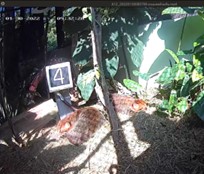A Preliminary Study on Basking Behavior of Flat-Headed Cats Prionailurus planiceps
Keywords:
flat-headed cat , Prionailurus planiceps , basking behavior, sunbathing, Songkhla ZooAbstract
Background and Objectives : Flat-headed cats Prionailurus planiceps is classified as an endangered species according to IUCN Red List of Threatened Species (Wilting et al., 2015). It is believed that there are very few of them left in natural habitats in Thailand. There are only four of them left in Songkhla Zoo including one last female. There is very limited information on this species, particularly daily behaviors that can be used to promote these captive cats’ physical and mental health. Understanding their behaviors may be useful for enrichment programs that assist increasing probability of their reproductive success. This study aimed to understand the basking behavior that helps the cats in regulating their body temperature, resting, relaxing their muscles, decreasing pain, and reducing parasites. Therefore, we preliminarily observed both female and male cats at the time they were allowed to stay together to get more information about the basking behavior. It is expected that the findings will be useful in better management and care for their better quality of life in captivity.
Methodology : This study focused on one female and one male flat-head cats in Songkhla Zoo, 12 and 13 years old, respectively. An enclosure or a cage for each cat is approximately 18 square meters with some plants, resting or sleeping box or artificial tree hollow, and with a three-square meters-pond with some fish and ad libitum water. Usually, the cats are in separated cages. During this study, they were allowed to live together within the two connected enclosures. There were some CCTV cameras both at the upper and the lower positions within each cage. In this study, five more cameras were installed in each one to increase the possibility to see the cats. We recorded videos of the two cats during 25–30 January 2022. The behaviors were observed by using continuous focal animal sampling technique. Behaviors during basking were classified into states (lying, sleeping, walking, standing and sitting) and event ones in comparison mainly with Felidae behaviors in Stanton et al. (2015). Durations and frequencies of each behavior were recorded and were compared between the female and the male.
Main Results : For this preliminary study, it is found that the cats did not bask on the first two days (25–26 January 2022) with low sunlight. They did basking, when sunlight was available, between 27–30 January 2022 from 08.00–10.49 h. The female spent more time in basking than the male (7 min. 49 sec. to 2 hr. 23 min., 58 sec., average 1 hr. 16 min. 43 sec. ± 1 hr. 45 min). While the male spent from no time to 1 hr. 3 min. 50 sec. (average 33 min. 23 sec. ± 31 min. 48 sec.). The female basked only for a short period (approx. 8 min.) while the male did not come outside his sleeping tree hollow on the morning the watering system inside both cages was on. State behaviors during basking were lying, sleeping, sitting, standing and walking. Among those, lying (53.5–94.5% in female, 63.3–79.2% in male) and sleeping (0–44.8% in female, 0–35.6% in male) were found the most in both female and male. The event ones were classified into 19 categories; watching, watching the other cat, sniffing, sniffing the other cat, grooming, head shaking, body shaking, insect repelling, stretching, yawning, urine walking, opening mouth (for reducing heat), threatening, staring at the other cat, avoiding, retreating, body rubbing, flehmen, and looking at fish or objects in the pond. Among these, insect repelling, opening mouth and watching something specifically in the pond are recorded in this study. Basking behavior itself was not also classified in Stanton et al. (2015). Behaviors during basking with the highest frequencies in the female were watching, sniffing, watching at the male, and grooming, respectively. While sniffing, watching, grooming and watching at the female were seen the most during in the male. During basking, both cats spent most their time in watching. Other than watching and sniffing the other cat, other social and sexual behaviors found during this study were threatening by the female, avoidance by the male, staring at the other cat and retreating from the other. Between or after basking, the cats usually went to the pond inside the cage to dip themselves in the water or to drink some water. This wetland related behaviors are not included in this report because they were seen when the cats’ body were not under sunlight. Opening mouth was also found in both individuals shortly before the end of the basking to reduce dehydration. Behaviors of female and male during basking each day were significantly different (P = 0.017).
Conclusions : Flat-headed cats basked on sunny days around 08.00–11.00 h. The female spent more time under sunlight than the male. Most state behaviors found were lying and sleeping, respectively. Nineteen event behaviors were found during basking. Among those, watching, sniffing and grooming were often observed. The social behaviors observed included watching and sniffing each other, as well as threatening and avoiding after being threatened. In each day, female’s and male’s behaviors were significantly different (P = 0.017). The suggestions from this study were preserving basking areas for the cats, avoiding disturbances during basking.
References
Altman, J. (1974). Observational study of behaviors: Sampling methods. Behaviour, 49, 227–267.
Baker, M.A. (1984). Cardiovascular and respiratory responses to heat in dehydrated dogs. American Journal of Physiology, 246(3 Pt 2), R369-74.
Boyer, D.R. (1965). Ecology of the basking habit in turtles. Ecology, 46(1/2), 99–118.
Bush, S.E., & Clayton, D.H. (2018). Anti-parasite behaviour of birds. Philosophical transactions of the Royal Society B: Biological Sciences, 373(1751), 20170196.
Danaisawadi, P., Piriyarom, S., Krasaeden, W., Pramkasem, S., Rurkkhum, S., & Yimprasert, S. (2023). Time budget and activity patterns during the mating period of flat-headed cat Prionailurus planiceps in captivity. Tropical Natural History, 7, 221–228.
Geiser, F., Goodship, N., & Pavey, C. (2002). Was basking important in the evolution of mammalian endothermy?.Naturwissenschaften, 89(9), 412–414.
Houston, D.C. (1980). A possible function of sunning behaviour by griffon vultures, Gyps spp., and other large soaring birds. Ibis, 122(3), 366–369.
Lekagul, B., & McNeely, J. (1988). Mammals of Thailand. Bangkok: Association for the Conservation of Wildlife.
Quenette, P.-Y. (1990). Functions of vigilance behaviour in mammals: a review. Acta Ecologica, 11(6), 801–818.
Stanton, L.A., Sullivan, M.S., & Fazio, J.M. (2015). A standardized ethogram for the Felidae: A tool for behavioral researchers. Applied Animal Behaviour Science, 173, 3–16.
Steinbrecher, F., Dunn, J.C., Price, E.C., Buck, L.H., Wascher, C. , & Clark, F.E. (2023). The effect of
Anthropogenic noise on foraging and vigilance in zoo housed pied tamarins. Applied Animal Behaviour Science, 265, 105989.
Subagyo, A., Supriatna, J., Andayani, N., Mardiastuti, A., & Sunarto, S. (2020). Diversity and activity pattern of wild cats in Way Kambas National Park, Sumatra, Indonesia. IOP Conference Series: Earth and Environmental Science, 481, 012005.
Sunquist, M., & Sunquist, F. (2002). "Flat-headed cat Prionailurus planiceps (Vigors & Horsfield, 1827)". Wild Cats of the World. Chicago: The University of Chicago Press.
Susan, M.C., & Macdonald, D. (2011). Wild felid diversity and activity patterns in Sabangau peat-swamp forest, Indonesian Borneo. Oryx, 45, 119–124.
Welp, T., Rushen, J., Kramer, D.L., Festa-Bianchet, M., & Passillé, A.M.B. (2004). Vigilance as a measure of fear in dairy cattle. Applied Animal Behaviour Science, 87(1–2), 1–13.
Wilting, A., Brodie, J., Cheyne, S., Hearn, A., Lynam, A., Mathai, J., McCarthy, J., Meijaard, E., Mohamed, A., Ross, J., Sunarto, S., & Traeholt, C. (2015). Prionailurus planiceps. The IUCN Red List of Threatened Species, e.T18148A50662095.

Downloads
Published
How to Cite
Issue
Section
License
Copyright (c) 2025 Faculty of Science, Burapha University

This work is licensed under a Creative Commons Attribution-NonCommercial-NoDerivatives 4.0 International License.
Burapha Science Journal is licensed under a Creative Commons Attribution-NonCommercial-NoDerivatives 4.0 International (CC BY-NC-ND 4.0) licence, unless otherwise stated. Please read our Policies page for more information



